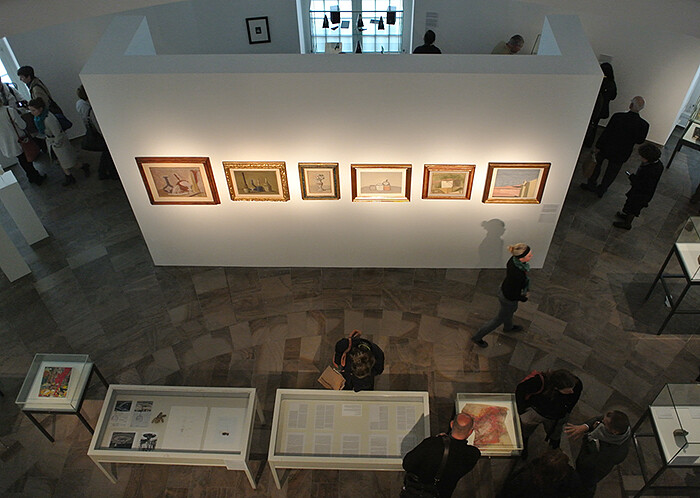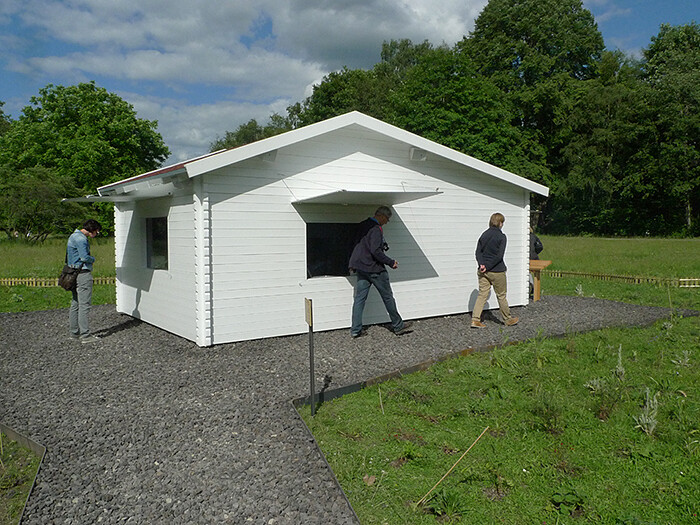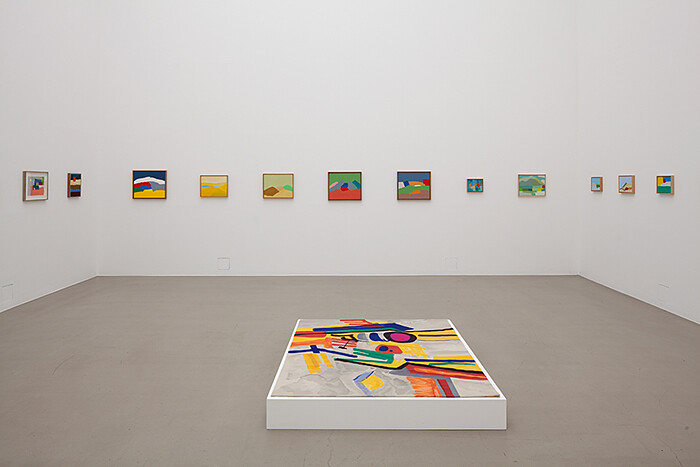“When we read, there is a voice inside our minds that narrates aloud, but silently, in what has been termed ‘subvocalization.’ Our accelerated way of life—the dissemination of speed-reading techniques, for example—dissolves that voice. In response, the Writers Residency seeks moments of ‘chorality’: instances of mutual commitment, whether loud or muted … through its location in the Dschinghis Khan Restaurant, the Writers’ Residency investigates the possibilities of privacy in a public space.”
Why did this passage in Documenta 13’s flood of press materials so hook me? Perhaps because as I moved through the mega-exhibition and its installations and performances and archives of artists, poets, musicians, theorists, feminists, physicists, and art-world drop-outs that comprise the participants of Carolyn Christov-Bakargiev’s supremely impressive and affecting show, the words “commitment” and “privacy” kept appearing refrain-like in my thoughts. Certainly this was the most politically committed exhibition I could remember ever seeing (the tired and exploitive “political” theatrics of the recent Berlin Biennale notwithstanding). And certainly the radical intimacy of so many of the works and creative lives on view at Documenta 13 presented an expanded definition of the role of the internal life within institutional space. That their Writers’ Residency takes place in a restaurant called Dschinghis Khan situated in Mittel-Deutschland only added the entirely welcome note of humor, which the seriousness of this endeavor necessitated and thankfully did not lack.
The opening halls and rooms of the late 18th-century Fridericianum, with Ceal Floyer’s sound piece and Ryan Gander’s gusty corridor, were a bit of a bait-and-switch: things quickly got much more material. In the glass-enclosed rotunda, a constellation of disparate works carried on an entirely elliptical conversation (or chorus) as poetic and strange as one might encounter. Here that chorus included two Judiths’ delicate works in paper (with Hopf contributing modernist-cum-technological white masks printed by a 3-D printer and stemming from an unattributed mask found at a German girl’s school and Barry offering polyhedron models featuring an encyclopedic admixture of images and text); Giorgio Morandi’s vases; Mohammed Yusuf Asefi’s oil landscapes; and Lee Miller’s infamously indiscreet and weirdly powerful images of Hitler’s Munich apartment, among others.
Upstairs I encountered my favorite works: Hannah Ryggen’s series of anti-fascist, tapestries from the 1930s and ’40s. Evoking the lineation of Käthe Kollwitz and the penetrating breadth of Guernica, they blew my mind. So too did the alarmingly comprehensive and nuanced series of apples painted by the Bavarian priest and gardener Korbinian Aigner, who created four new strains of apples while he was held prisoner at Dachau. In both Ryggen’s and Aigner’s cases, and as with so many of the Documenta 13 participants, the private and sterling commitment of their lives did not overshadow the peculiar and unarguable strength of their works. Instead the public and the intimate, their art and their life, revealed themselves to be patently, genetically entwined, one impossible to regard without its mirroring and enabling other.
These two artists were also emblematic of certain strains of Christov-Bakargiev’s curatorial style here (if style is character, as the saying goes, then hers is defiantly revealed). More of the Documenta participants are removed or estranged from the Western art-historical canon and capital- and hype-infused present than I have ever encountered in a biennial-like show before. This is either by age and politics and medium—as is the case with Ryggen and Aigner and so many of the other included artists who were born nowhere near the much-favored 1970s and ’80s—or by geography. Or it is by choice: one of my favorite moments was while sitting on the floor of a blacked-out room while the American West Coast musician, artist, and literal one-man-band Llyn Foulkes (born 1934) serenaded us with his jazzy improvisations on “The Machine,” a self-made musical sculpture of scavenged horns, drums, whistles, and the like. If its look conjured Lee Bontecou’s violent 1960s-era wall reliefs, the machine’s sound suggested a marriage of Bertolt Brecht’s noir-ish “Hollywood Elegies” poems (limning swimming pools, film directors, cars, fast ladies, and fascism) and Randy Newman’s coy “I Love LA” balladry. Foulkes’s early departure from the famed Ferus Gallery, and his recent three-dimensional paintings of speculative, planetary landscapes, make him both iconic and iconoclastic.
The sprawling grounds of the Karlsaue Park, meanwhile, is punctuated by small huts and greenhouses that feature a more familiar bag of contemporary video art and installation. If Omer Fast’s creepy and incestuous Continuity (2012) made me want to take a shower (the expert film follows a bourgeois German couple as they hire male escorts to enact the speculative homecoming of the son that they lost in Afghanistan), then Joan Jonas’s spellbinding fragments of films and installation video-clips mixing sound, text, sculpture, drawing, and video made me want to stay at her white-painted cabin for hours. In between were greenhouses filled with Thea Djordjadze’s and Jimmie Durham’s delicate museological tableaux of objects, at once poetic and wryly political.
Nevertheless, the exhibition’s near-hysterical number of participants, venues, and performances means that every critic writing so far has included a preface or a coda releasing them from the responsibility of thoroughness. I too will play that card here. But let me mention a few standouts that stood in relief against the dusky masses. In the Documenta Hall, I found an installation of petite, color-soaked paintings by poet, painter, and activist Etel Adnan; on the Konigsplatz, in a small, surreal red-and-silver theater worthy of David Lynch, I watched Alexandra Bachzetsis’s new performative work Etude (2012), in which a cast of dancers and musicians perform their autonomous selves through sport, krumping, looped guitar, and vocal recitation. Its actors enacted both the self-striving needed to distinguish itself from the chorus-like crowd, and the crowd itself, in which the self is at times destined to disappear.
Likewise was the case with Charlotte Salomon’s epic and seminal “Life? or Theater? A Play with Music” series of gouaches and text on paper: a story of love and family and persecution and supplication. Finished in 1942, they were found in France after she was killed at Auschwitz. The sympathetic, engrossing, and entirely singular voice that narrates Salomon’s work, manifested in a blocky, modernist scrawl of paint across her pages, is at once the interior voice of the author’s characters and, as the spectator moves slowly past the glass vitrines reading the story, the voice of the reader absorbed in it. Here, then, Christov-Bakargiev’s stated intention to create “chorality” was conjured, in the charged moment when the voice of the artist and the voice of the audience, the speaker and the receiver, briefly syncs. If the sound that results is not the fey and outdated humanist’s ideal of harmonics and complete fusion—Salomon’s work is too dark for that, as is the space in which it is shown at Documenta, infused as it is with the history of Nationalist Socialism—then it is something newer and stranger, older and more familiar, autonomous and potent. It is the sound of the mutual commitment (to art, to life, to history, and to death) that Christov-Bakargiev incisively wrote of in the ever-profane space of a press release.
Much has already been writ about the artistic director’s infamous spirituality, and her interest in animals, the immaterial, and nonhuman life. If her remark equating women and dogs (via the question of suffrage) is getting much enjoyable media play, it strikes me as odd that no one has connected its sad wit with Lee Lozano’s equally sharp and incendiary feminist statement/project that found her declaring that she would no longer speak to women. In any case, much of the critique leading up to this Documenta has had more than a whiff of the easy and automatic misogyny that so many in the art world (and without) hold on to like priests clutching their rosaries. Accordingly, before I began writing the review you are reading now, I considered only writing about the women artists included in the show, as a sign of solidarity with this exemplary feminist exhibition—but then I couldn’t bear to ignore a certain Bavarian apple painter, nor a certain LA art-world dropout, nor others. In any case, despite the attention fostered by both Christov-Bakargiev herself and her critics on her vaunted interest in the nonhuman world, what I found most startling about Documenta 13 was how entirely human it was, and how engaged with the world that we (joyfully, sorrowfully, weirdly) inhabit. If that sounds lamely human-centric and passé, so be it. It’s a deeply intelligent, stringent, surprising, and entirely committed (yes, that word again) showing of the potentiality of private lives accorded the most public of stages.









